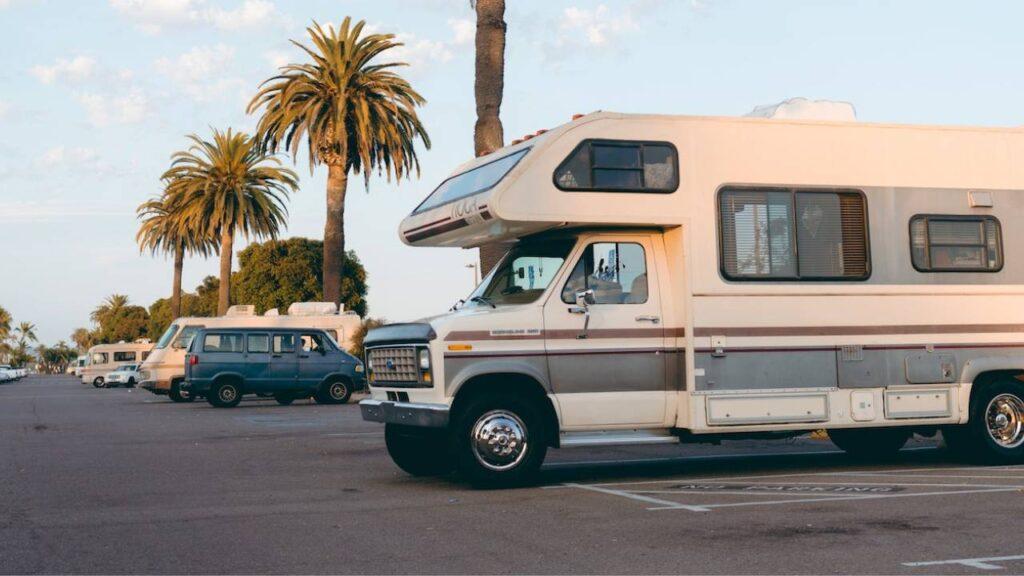
When you’re on the road, your RV becomes your home away from home. One of the most frustrating issues that can arise is a leak in your RV’s roof. Not only can it cause significant damage, but it can also ruin your travel plans. Fortunately, with some basic tools and knowledge, you can fix these leaks yourself. This guide “Tips for Fixing a Leak In Your RV’s Roof” will walk you through the steps to identify, repair, and prevent leaks in your RV’s roof.
Identifying the Source of the Leak
Before you can fix a leak, you need to locate its source. Leaks can be tricky because water often travels before it drips down inside your RV. Here’s how to pinpoint the source:
Inspect the Interior
Start by examining the interior of your RV for water stains or damp spots on the ceiling and walls. Use a flashlight to look for discoloration or mold, which can indicate where the water is entering. Don’t forget to check inside cabinets and around windows as water can travel along unexpected paths. If you notice any musty odors, that’s a red flag for mold, which usually accompanies leaks.
Examine the Roof
Climb up to the roof and inspect it for obvious signs of damage such as cracks, holes, or lifted seams. Pay special attention to areas around roof vents, air conditioners, skylights, and antennas, as these are common leak points. It’s a good idea to use a ladder that safely supports your weight and ensures you can move around the roof without causing further damage.
Perform a Water Test
If you can’t find the source, enlist a helper to spray water on the roof with a hose while you stay inside the RV to watch for drips. Start from the lowest point of the roof and work your way up. This method can help you trace the leak to its origin. Be patient, as it might take some time for the water to seep through and show up inside.
Preparing for the Repair
Once you’ve identified the source, it’s time to prepare for the repair. Proper preparation ensures a more effective and lasting fix.
Gather the Necessary Tools and Materials
Depending on the type of roof your RV has, you may need different materials. Common items include:
- Roofing tape or patches
- Sealant (appropriate for your roof type)
- Caulk gun
- Clean rags
- Roof cleaner
- Putty knife
- Scrub brush
Make sure to check the manufacturer’s recommendations for any specific products suited to your RV’s roof material.
Clean the Area
Clean the area around the leak thoroughly. Remove any dirt, debris, or old sealant. Use a roof cleaner and a scrub brush to ensure the surface is as clean as possible. This step is crucial for ensuring the new sealant adheres properly. Dry the area completely before proceeding to the next step to avoid trapping moisture under the repair material.
Repairing the Leak
With the area clean and your materials ready, you can now fix the leak. Follow these steps for a successful repair.
Apply Roofing Tape or Patch
For small holes or cracks, roofing tape or patches are a quick and effective solution. Cut the tape or patch to size, ensuring it covers the damaged area with some overlap. Press it firmly onto the roof and smooth out any air bubbles. Roofing tape works best on flat surfaces, so make sure to flatten out the area as much as possible.
Use Sealant for Seams and Larger Areas
For larger leaks or seams, apply a generous amount of sealant. Use a caulk gun to apply the sealant evenly over the damaged area. Smooth it out with a putty knife, making sure it fills any cracks or gaps completely. Sealants come in various types, such as silicone or rubber-based, so choose one that’s compatible with your roof material.
Allow the Sealant to Cure
Most sealants need time to cure and bond properly. Check the manufacturer’s instructions for specific curing times. Avoid using the RV or exposing the roof to water until the sealant has fully cured. This waiting period ensures that the repair is strong and long-lasting.
Preventing Future Leaks
After repairing the leak, take steps to prevent future leaks and protect your RV’s roof.
Regular Inspections
Regularly inspect your RV’s roof, especially after severe weather or long trips. Look for any signs of wear or damage and address them promptly to prevent small issues from becoming major problems. Make a habit of walking around your RV and checking the roof every few months.
Apply a Roof Coating
Consider applying a roof coating to provide an extra layer of protection. Roof coatings can extend the life of your roof and make it more resistant to leaks. Choose a coating that is compatible with your roof material. These coatings often have reflective properties that can also help keep your RV cooler in hot weather.
Maintain Seals and Seams
Keep an eye on the seals and seams around roof openings and attachments. Reapply sealant as needed to ensure they remain watertight. Checking these areas every few months can save you from costly repairs down the line. Regularly maintaining these seals can significantly prolong the life of your roof.
Understanding Different RV Roof Types
RV roofs come in various materials, each with its own characteristics and maintenance needs. Understanding your roof type is essential for effective leak repairs.
Rubber Roofs (EPDM and TPO)
Rubber roofs are common in many RVs due to their durability and flexibility. EPDM (ethylene propylene diene monomer) and TPO (thermoplastic olefin) are two types of rubber roofing. They are generally easy to repair with rubber roof sealants and patches. Rubber roofs are lightweight and have good resistance to weather and UV rays, but they can be punctured by sharp objects.
Fiberglass Roofs
Fiberglass roofs are sturdy and provide good protection against leaks. Repairs typically involve fiberglass repair kits or special adhesives designed for this material. Fiberglass is durable and resistant to dents, but it can develop cracks over time, especially if exposed to extreme temperatures.
Aluminum Roofs
Aluminum roofs are lightweight and resistant to rust. However, they can develop leaks around seams and attachments. Aluminum tape and compatible sealants work well for these repairs. Aluminum is durable and fire-resistant but can be noisy during rain and hailstorms.
Common Mistakes to Avoid
Even with the best intentions, DIY repairs can sometimes go wrong. Here are some common mistakes to avoid:
Skipping the Cleaning Step
Failing to clean the area thoroughly before applying repair materials can prevent the sealant from adhering properly. Always clean and dry the area first. Any dirt or debris can compromise the seal and cause the repair to fail prematurely.
Using the Wrong Sealant
Different roof materials require specific types of sealants. Using the wrong sealant can lead to ineffective repairs. Check the manufacturer’s recommendations for the best product for your roof type. Using the wrong product can result in poor adhesion and a shorter lifespan of the repair.
Ignoring Manufacturer Instructions
Whether it’s the sealant’s curing time or the application process, ignoring manufacturer instructions can compromise the repair. Follow the directions carefully to ensure a successful fix. These instructions are designed to maximize the effectiveness and durability of the product.
When to Seek Professional Help
While many RV roof leaks can be repaired with DIY methods, there are times when professional help is needed.
Extensive Damage
If the damage is extensive or the roof structure is compromised, it’s best to seek professional assistance. Professionals can assess the damage and provide a long-term solution. Extensive damage may require specialized RV mechanics tools and materials that are not readily available to the average RV owner.
Persistent Leaks
If you’ve attempted repairs but the leak persists, a professional can identify underlying issues that might not be apparent. Persistent leaks can lead to mold and structural damage if not addressed properly. Professionals have the experience and equipment to thoroughly diagnose and repair the issue.
Maintaining Your RV Roof for Longevity
Proper maintenance is key to extending the life of your RV’s roof and preventing leaks.
Seasonal Checks
Conduct thorough inspections at least twice a year, ideally in the spring and fall. Look for any signs of wear and tear, and address issues immediately. Seasonal changes can affect the integrity of your roof, so regular checks are essential.
Clean Regularly
Regularly clean your RV’s roof to prevent the buildup of dirt and debris, which can lead to damage. Use appropriate cleaners for your roof material to avoid causing harm. A clean roof is less likely to develop mold and other issues that can lead to leaks.
Store Properly
If you store your RV for extended periods, use an RV cover to protect it from the elements. Proper storage can prevent damage and reduce the need for frequent repairs. A quality RV cover can shield your roof from UV rays, rain, and snow, preserving its condition.
Wrapping It Up!
Fixing a leak in your RV’s roof doesn’t have to be a daunting task. By identifying the source, preparing properly, and using the right materials, you can effectively repair leaks and extend the life of your RV’s roof. Regular maintenance and inspections are crucial in preventing future leaks and ensuring that your RV remains a safe and comfortable home on the road. Remember, if the damage is extensive or persistent, seeking professional help is always a wise choice.
Related FAQs
How can I temporarily fix a leak in my RV’s roof while on the road?
Temporary fixes include using waterproof tape or a tarp to cover the damaged area until you can make a permanent repair. These solutions can hold up for a short period, giving you time to reach a place where you can perform a proper fix.
Is it safe to walk on my RV’s roof?
It depends on your RV’s roof structure. Always check your owner’s manual. If walking on the roof, distribute your weight evenly and avoid stepping on weak areas. Some RV roofs are designed to support the weight of a person, while others may not be as robust.
Can I use household sealants for RV roof repairs?
No, household sealants are not designed for RV roofs and may not withstand the elements. Use sealants specifically made for RV roofing. These specialized products are formulated to endure the movement and weather conditions typical for RV roofs.
How often should I inspect my RV roof for leaks?
Inspect your RV roof at least twice a year and after any severe weather events. Regular inspections can help you catch small problems before they become big ones.
What are the signs of a roof leak inside my RV?
Signs include water stains, damp spots, mold, and a musty odor inside the RV. If you notice any of these signs, it’s important to address them quickly to prevent further damage.
Should I replace my RV roof if it has multiple leaks?
If your roof has extensive damage and multiple leaks, it might be more cost-effective to replace it rather than repair it repeatedly. A new roof can provide peace of mind and long-term protection.
As outdoor enthusiasts ourselves, we understand the significance of reliable gear that can withstand the elements and support you throughout your journey. We try to provide as much real life information with our guides and how tos to the readers as possible. Our honest and transparent reviews of essential outdoor gadgets and products are rooted in testing and experience. We take great satisfaction in offering unbiased evaluations, ensuring that you can make informed decisions when investing in outdoor gear. As an affiliate website, we may earn a small commission from some of the products we feature. However, rest assured that our opinions are not influenced by this, and your trust is always our top priority.



